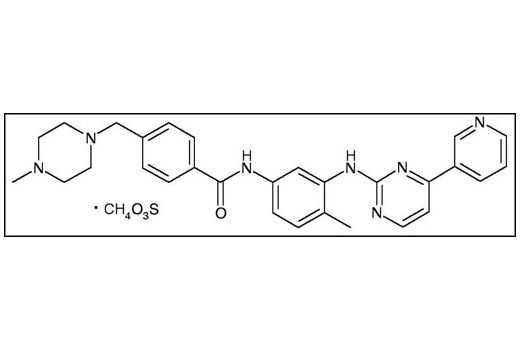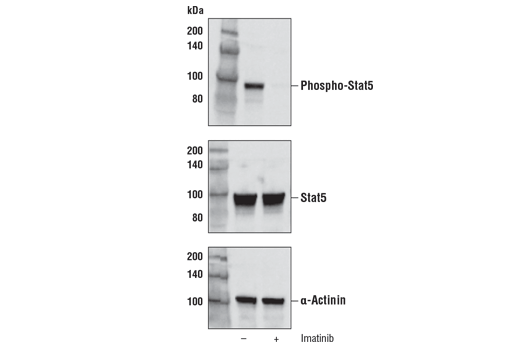Background
Imatinib is a tyrosine kinase (TK) inhibitor that is a relatively specific ATP-binding site antagonist of Bcr-Abl, PDGF receptor, and c-Kit TKs (1-3). Results are encouraging in chronic myeloid leukemia (CML) clinical trials and imatinib has become a paradigm for targeted cancer therapeutics (4-6). Signal transduction through phospho-tyrosine pathways has been studied extensively, and tyrosine phosphorylation has been linked to multiple cell growth and differentiation pathways (7-9). Because the observed leukemic state of CML is dependent on the intact Bcr-Abl tyrosine kinase activity, extensive work has been done to identify substrates of Bcr-Abl and thus possible mechanisms leading to a myeloid expansion. Many groups have characterized prominent tyrosine-phosphorylated protein substrates in both CML blasts and Bcr-Abl-expressing cell lines, including SHIP, c-Cbl, Dok, Shc, and CrkL (10-15). In addition, key signal transduction pathways involving PI3 kinase, Ras, Myc, and Stat5 are also activated in a Bcr-Abl kinase-dependent manner (16).
- Buchdunger, E. et al. (1996) Cancer Res 56, 100-4.
- Heinrich, M.C. et al. (2000) Blood 96, 925-32.
- Druker, B.J. et al. (1996) Nat Med 2, 561-6.
- Mauro, M.J. and Druker, B.J. (2001) Curr Oncol Rep 3, 223-7.
- Druker, B.J. et al. (2001) N Engl J Med 344, 1031-7.
- Druker, B.J. et al. (2001) N Engl J Med 344, 1038-42.
- Blume-Jensen, P. and Hunter, T. (2001) Nature 411, 355-65.
- Ullrich, A. and Schlessinger, J. (1990) Cell 61, 203-12.
- Cantley, L.C. et al. (1991) Cell 64, 281-302.
- ten Hoeve, J. et al. (1994) Blood 84, 1731-6.
- Matsuguchi, T. et al. (1994) J Biol Chem 269, 5016-21.
- Carpino, N. et al. (1997) Cell 88, 197-204.
- Sattler, M. et al. (1997) Oncogene 15, 2379-84.
- Di Cristofano, A. et al. (1998) J Biol Chem 273, 4827-30.
- Wisniewski, D. et al. (1999) Blood 93, 2707-20.
- Kabarowski, J.H. and Witte, O.N. (2000) Stem Cells 18, 399-408.
Molecular Formula
C29H31N7O + CH4SO3
Molecular Weight
589.71 g/mol
Purity
>99%
CAS
220127-57-1
Solubility
Soluble in DMSO at 100mg/ml and H2O at 200mg/ml.
Storage
Directions for Use
Imatinib is supplied as a lyophilized powder. For a 10 mM stock, reconstitute the 5 mg in 847.9 μl DMSO. Working concentrations and length of treatment can vary depending on the desired effect, but it is typically used at 1-10 μM for 1-2 hours. Soluble in DMSO at 100 mg/ml; poorly soluble in ethanol. Soluble in water at 200 mg/ml.
Background References
Cross-Reactivity Key
H: human M: mouse R: rat Hm: hamster Mk: monkey Vir: virus Mi: mink C: chicken Dm: D. melanogaster X: Xenopus Z: zebrafish B: bovine Dg: dog Pg: pig Sc: S. cerevisiae Ce: C. elegans Hr: horse GP: Guinea Pig Rab: rabbit All: all species expected
Trademarks and Patents
Limited Uses
Except as otherwise expressly agreed in a writing signed by a legally authorized representative of CST, the following terms apply to Products provided by CST, its affiliates or its distributors. Any Customer's terms and conditions that are in addition to, or different from, those contained herein, unless separately accepted in writing by a legally authorized representative of CST, are rejected and are of no force or effect.
Products are labeled with For Research Use Only or a similar labeling statement and have not been approved, cleared, or licensed by the FDA or other regulatory foreign or domestic entity, for any purpose. Customer shall not use any Product for any diagnostic or therapeutic purpose, or otherwise in any manner that conflicts with its labeling statement. Products sold or licensed by CST are provided for Customer as the end-user and solely for research and development uses. Any use of Product for diagnostic, prophylactic or therapeutic purposes, or any purchase of Product for resale (alone or as a component) or other commercial purpose, requires a separate license from CST. Customer shall (a) not sell, license, loan, donate or otherwise transfer or make available any Product to any third party, whether alone or in combination with other materials, or use the Products to manufacture any commercial products, (b) not copy, modify, reverse engineer, decompile, disassemble or otherwise attempt to discover the underlying structure or technology of the Products, or use the Products for the purpose of developing any products or services that would compete with CST products or services, (c) not alter or remove from the Products any trademarks, trade names, logos, patent or copyright notices or markings, (d) use the Products solely in accordance with CST Product Terms of Sale and any applicable documentation, and (e) comply with any license, terms of service or similar agreement with respect to any third party products or services used by Customer in connection with the Products.

